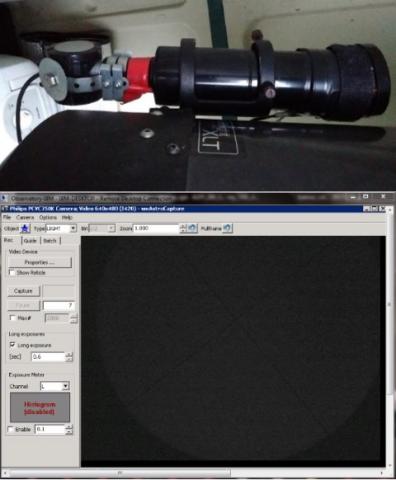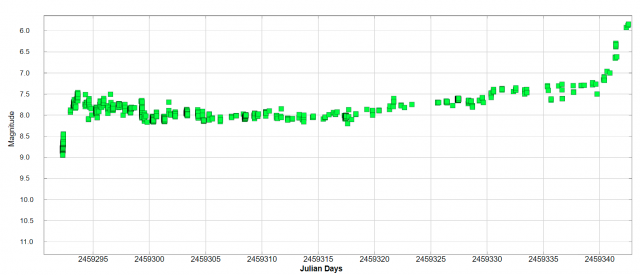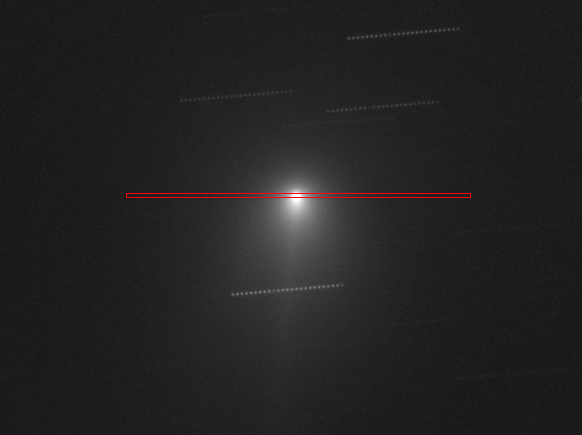Forum Replies Created
-
AuthorPosts
-
 Robin LeadbeaterParticipant
Robin LeadbeaterParticipantWhile watching the recent partial eclipse in largely cloudy skies I wondered if it might be possible to follow an eclipse even in cloudy conditions in spectra of the sky. The shape of the spectrum line profiles should alter slightly as different parts of the rotating solar disc are covered. (Similar to the Rossiter-McLaughlin effect see in the spectrum of eclipsing binaries) Does anyone know if this type of observation has ever been attempted ?
Cheers
Robin
 Robin LeadbeaterParticipant
Robin LeadbeaterParticipantAgainst all odds there is actually intermittent sun here
 Robin LeadbeaterParticipant
Robin LeadbeaterParticipantHere are 6 spectra around that date from the BAA spectroscopy database (From David Boyd (2), Kevin Gurney, Hugh Allen, John Coffin and me)
They all line up in wavelength precisely
Cheers
Robin
 Robin LeadbeaterParticipant
Robin LeadbeaterParticipantIn fact I see further down the thread Hugh actually wavelength calibrated Mike’s prism spectrum to produce a graph of the spectrum with a linear wavelength axis.
https://britastro.org/comment/10463#comment-10463
You can see there that the wavelengths then agree in Mike’s Hugh’s and my spectra (and indeed with those by David Boyd and John Coffin in the same thread)
 Robin LeadbeaterParticipant
Robin LeadbeaterParticipantI just checked mine and Hugh’s spectra from 23rd March in the Nova Cas 2021 thread. The graphed spectra are calibrated in wavelength with a linear X axis and the Balmer (and other line) wavelengths are correct and consistent between the two spectra
https://britastro.org/comment/10272#comment-10272
https://britastro.org/comment/10277#comment-10277
Mike’s spectrum image is not calibrated in wavelength.
https://britastro.org/comment/10242#comment-10242
Prism spectra are very non linear with the short wavelength end significantly stretched and the longer wavelengths compressed
 Robin LeadbeaterParticipant
Robin LeadbeaterParticipantAll spectrographs are non linear to at least some degree and have to be individually calibrated in wavelength. Mike’s spectrograph is fundamentally different to mine for example. His uses a prism and the dispersion is due to refraction whereas mine (and Hugh’s) uses a diffraction grating and the dispersion is due to diffraction. As a result the relationship between wavelength and distance along the spectrum are completely different and in fact run in opposite directions ! (with diffraction the short wavelengths are least deflected whereas in refraction the short wavelengths are refracted the most)
Cheers
Robin
 Robin LeadbeaterParticipant
Robin LeadbeaterParticipantThe ASI 034MC was an astro camera not a webcam though and cost new similar to the current equivalent ASI120 (~£120). Cheaper domestic webcams would not go as deep. Add to that the cost of the specially adapted guidescope and you can see why a commercial equivalent to this design is going to cost ~£200
 Robin LeadbeaterParticipant
Robin LeadbeaterParticipantJust come across this on “Cloudy Nights”. I’ve not tried it but it looks like you strap the phone to your scope, centre a nearby bright star in the main scope and then use the phone as a “virtual sky” to hop to your target
 Robin LeadbeaterParticipant
Robin LeadbeaterParticipantHere is my DIY version using Meccano and Jubilee clips used as an electronic finder on my remote setup. I don’t find it that sensitive though with the old webcam I am using, perhaps mag 4-5. (Maybe more modern webcams are better) Good enough to put a bright star in the main camera field to do a local sync of the goto though.
Cheers
Robin
 15 May 2021 at 4:02 pm in reply to: observations page does not reset to first page after changing filters #584208
15 May 2021 at 4:02 pm in reply to: observations page does not reset to first page after changing filters #584208 Robin LeadbeaterParticipant
Robin LeadbeaterParticipantYes, it now resets to the first page when changing filters which is more logical I think
Thanks!
 Robin LeadbeaterParticipant
Robin LeadbeaterParticipantThe steady rise has turned into a rapid brightening to mag 6 currently

 Robin LeadbeaterParticipant
Robin LeadbeaterParticipantThe spectrum of the central coma is now on my BAA observer’s page here
 Robin LeadbeaterParticipant
Robin LeadbeaterParticipantHad another go at this one. Here it is in the BAA database overlaid on Pickles G0v)
https://britastro.org/specdb/data_graph.php?obs_id=9503&std_spectra_id=p_g0v
(One of the most frustrating observations I have tried to make. It literally skimmed along the roof line just arcminutes below it for over an hour before it finally popped up just as the sky was starting to brighten.) It was still at air mass 3.5 and there was thin cloud so the SNR is poor but consistent with the type reported previously (late F /early G)
https://www.astronomerstelegram.org/?read=14593
Cheers
Robin Robin LeadbeaterParticipant
Robin LeadbeaterParticipantHi Derek,
What date was this ? Objective grating setups showed a nice little sodium coma and tail.
My early example on 7th July
https://britastro.org/comment/8806#comment-8806
and a better one a few days later by Mike Harlow
https://britastro.org/comment/8832#comment-8832
but the sodium dropped in intensity after that and was lost in low resolution spectra around 22nd July
Cheers
Robin
 Robin LeadbeaterParticipant
Robin LeadbeaterParticipantA spectrum has now confirmed it an “ordinary star” so the source of the variability is unclear.
https://www.astronomerstelegram.org/?read=14593
A series of spectra covering a period of variability could be interesting. (The clouds rolled less than a minute after I finally got the star on the slit of the ALPY600 when it finally cleared the rooftop at 16 deg altitude). Although extremely noisy, the spectrum is also consistent with the “normal star” description)
Cheers
Robin
 Robin LeadbeaterParticipant
Robin LeadbeaterParticipantOne of these perhaps ?
https://www.semrock.com/FilterDetails.aspx?id=FF01-387/11-25
seen in action here
https://wirtanen.astro.umd.edu/46P/CN_filter_test.shtml#Jorma_update
 Robin LeadbeaterParticipant
Robin LeadbeaterParticipantHere is the approximate extent of the spectrograph slit superimposed on Denis’s image.

The CN emission is actually much more intense than the raw spectrum image suggests as the spectrograph sensitivity is low in the UV. The comet would look pretty spectacular in a narrow band CN filter !
 Robin LeadbeaterParticipant
Robin LeadbeaterParticipantThe CN emission (line at the left edge) extends beyond the ends of the ~6 arcmin long slit
 Robin LeadbeaterParticipant
Robin LeadbeaterParticipantI took a low resolution spectrum across the coma last night. Here is the raw image including sky lines

 Robin LeadbeaterParticipant
Robin LeadbeaterParticipantHi Mike,
The database contains over 8000 spectra currently and is accessible to anyone. It is fully searchable by object name, type of object, observer, resolution, date and as with the variable star database, storing spectra here gives long term security of the data and it will likely still be available to researchers long after we have all passed on.
There is a link to all the BAA spectroscopy resources including the database as a sticky at the top of the section of the forum dedicated to spectroscopy.
https://britastro.org/forum/143
(These resources are all brought together on one page in the Equipment and Techniques section)
Cheers
Robin
-
AuthorPosts
